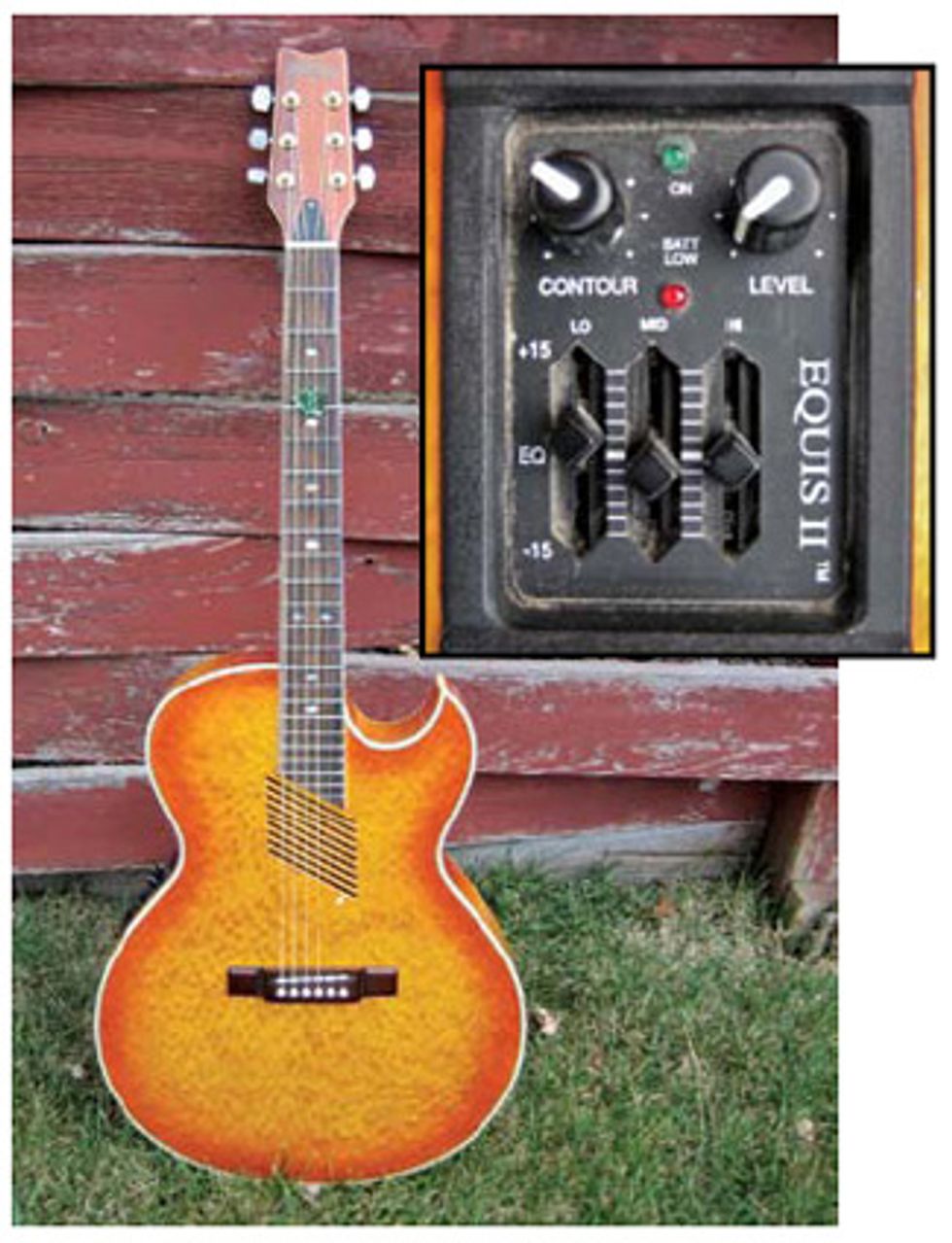The background of the Festival series from Washburn
 |
It’s hard to believe this instrument is nearly 20 years old now, but time flies when you’re playing guitar. I have a Washburn acoustic-electric, serial number S9201XXX, that I absolutely love to play. I’m wondering if you could tell me a little about it and what it’s worth. Also, the Equis electronics no longer work, and I’m hoping you have some advice on how to get it fixed. Thanks so much!
David
Bloomington, Illinois
Hey David,
Cool guitar—I actually have one just like it! This was my first acoustic, and it was a great guitar to learn on. It’s easy to play, sounds good, and the design is always a conversation starter.
Washburn History
The Washburn brand was introduced in the late 1880s by Lyon & Healy to produce quality stringed instruments for the ever-expanding distributor. Demand grew rapidly, and during the 1900s the company was producing up to 100 Washburn instruments per day. Lyon & Healy—along with Washburn— was eventually overtaken by the Tonk Bros. Company in the 1920s, and by the late 1940s the Washburn name was discontinued.
In 1974, the Washburn name was revived on a line of acoustic guitars, mandolins, and banjos imported from Japan. In the late 1970s, Washburn introduced new electrics and acoustic-electrics, including the revolutionary Festival Series, which is what your model is from. Washburn is actually something of a pioneer in electrified acoustics, and their Festival Series became popular stage instruments. They featured thin bodies, sharp Florentine cutaways, a transducer built into the bridge, and onboard electronics. Interest was high in these unusual guitars, and after a few years of tweaking, several models were listed in Washburn’s catalog. In the mid 1980s, Washburn moved production from Japan to Korea.
The Festival Series’ Background
Festival Series models all start with an “EA” prefix, usually followed by a two-digit number. Generally speaking, the higher the number, the fancier the guitar’s features. The popularity of the Festival Series is evidenced by how many artists had signature “EA” guitars, including Craig Chaquico, Nuno Bettencourt, and Gregg Allman, who had a black EA20 that he called Melissa. Several other artists played EA models as well, including John Jorgenson, Robert Plant, and even David Brooks (of the band Slammin’ Gladys) is pictured playing one in an early-1990s Washburn catalog.
Festival Series guitars were designed to sound good when amplified at high volumes. In this context, their laminated tops were preferable to the solid-wood tops found in more traditional flattops. Guitarists who performed with Festival Series Washburns did so because of the electric tones they produced.
Your Guitar
Based on the serial number, your guitar is a 1992 EA36 Marquee in vintage sunburst finish. It features bookmatched bird’s-eye maple top, back, and sides, a shallow body, rosewood fretboard and bridge, and Equis II electronics. What really sets the EA36 apart from other Festival Series guitars is that, instead of an oval soundhole, it has nine “computer designed” sound channels (early models only had six) that run diagonally under the fretboard. Today, very few guitars or even components are not designed using computers, but in the early 1990s this was certainly cutting-edge technology. The EA36 came in natural, tobacco sunburst, and vintage sunburst, as well as a rare blue finish available as a special order.
While the Festival Series has been successful (these guitars are still produced today, and several models are in Washburn’s current catalog), the model name and numbers were changed, switched, and reused several times on many different instruments. Before 1992, your guitar was actually called the EA46, and, after 1996, Marquee was dropped from the name. The EA36 was discontinued in 1997, and the last retail price was $1000. Looking at pictures of your guitar, it appears to be in Low Excellent condition, with a few dings. Based on that, today it is worth between $450 and $550.
Weighing Your Equis Options
To my knowledge, Equis is no longer making electronics or pickups, and Washburn stopped using them in the early 2000s. A quick internet search provided very little information as far as replacement parts or schematics. From what I’ve seen, these systems are not terribly complicated, and if you bring it to your local guitar tech or repair shop, they should be able to diagnose the problem and hopefully fix it. If not, you can explore replacing the electronics with a newer preamp and pickup system, but keep in mind that altering the original configuration will ultimately change the value. Once you get the electronics working, this guitar will be a treasure for years to come!
Source: Washburn—Over One Hundred Years of Fine Stringed Instruments by John Teagle.
Zachary R. Fjestad
Zachary is the author of the Blue Book of Acoustic Guitars, Blue Book of Electric Guitars, and the Blue Book of Guitar Amplifiers. For more info, visit bluebookinc.com or drop an email to guitars@bluebookinc.com. You can submit questions to:
Blue Book Publications
Attn: Guitar Trash or Treasure
8009 34th Ave. S. Ste #175
Minneapolis, MN 55425

